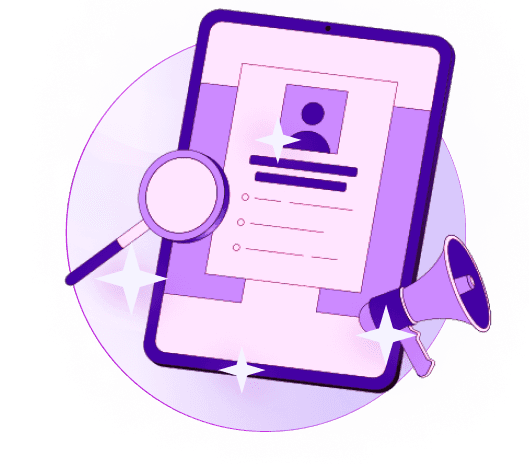Blogs
Articles

Intent-Based Marketing: Everything You Need to Know
Intent-based targeting changes how businesses connect with potential customers. Ads that utilize intent data perform 2.5 times better than those without. Today's customers expect tailored interactions from companies - 71% of them to be exact. The numbers tell the story: 47% of go-to-market teams already use intent data to generate leads.
Our years of experience in refining intent-based targeting for B2B companies have produced remarkable results. Digital breadcrumbs now provide valuable intent signals, and smart marketers use this data to focus their outreach efforts precisely. This strategy saves money by filtering out low-quality leads and speeds up the sales cycle by a lot.
Let's take a closer look at how you can create intent-based targeting flows that convert in 2025 and beyond!
What Is Intent-Based Marketing?
Intent-based marketing helps businesses target specific marketing materials to customers who show interest in purchasing a product or service. Companies identify and connect with prospects based on their behavior, interests, and digital footprints instead of using broad marketing approaches.
This approach makes use of information and analytics to understand customer actions and create tailored buying experiences. Marketing campaigns target people whose online behavior indicates purchase intentions rather than using widespread marketing efforts.
This strategy divides buyer intent into two categories. Active intent (transactional) shows a strong willingness to buy and often results in quick sales. Passive intent (informational) represents prospects who research without immediate purchasing needs.
To cite an instance, when someone searches "best CRM alternatives," a software company might spend more advertising budget to reach them with messages like "A cheaper and better alternative to Salesforce".
Intent-based marketing's strength lies in its precision. Businesses can identify prospects at various stages of their buying process by analyzing website visits, search queries, and content interactions. This targeted approach builds trust between customers and organizations and makes marketing campaigns work better.
What is intent-based targeting?
Intent-based targeting puts intent-based marketing principles into action. This approach creates tailored experiences for potential customers based on their online behavior and shown buying interest.
Traditional targeting methods rely on demographics alone. However, intent-based targeting looks at what people do during searches to spot prospects who actively research solutions like yours. The numbers tell a compelling story—ads with intent signals show 30% higher consideration and 40% higher purchase intent than those using demographic signals alone.
This strategy helps identify prospects early in their buying experience, before they reach out to any sales channels. Companies watch several intent signals such as:
Downloads of white papers or case studies
Clicks on demo links in emails
Time spent on product pages
Visits to competitor comparison sites
Social media reactions to feature announcements
Sales and marketing teams can track these activities and focus only on accounts that show real interest. This targeted approach helps teams learn about each lead's specific needs, which enables them to reach out with the right message at the perfect time.
Sales automation tools play a vital role in this process. They track lead activity, analyze intent data, and can trigger outreach based on predicted buying intent automatically.
Why Intent-Based Marketing Matters?
Personalization drives modern marketing success. 71% of customers expect personalized offers and user experiences when they visit websites. Businesses and customers benefit immediately from intent-based targeting that delivers this automatically.
Intent-based targeting provides significant business advantages beyond better user experiences. Companies can improve their search engine optimization by learning about their audience's interests. The right message reaches prospects at the perfect moment, which increases conversion chances.
The numbers tell an impressive story. Companies can allocate resources more efficiently by focusing on prospects who actively research solutions. The cost per lead might seem higher than traditional campaigns at first, but the quality of leads makes it worth the investment. This strategy creates higher marketing ROI through better conversions and less waste.
The data speaks volumes - 90% of US consumers find personalized marketing content appealing. Marketers can create customized experiences that appeal to potential buyers by analyzing their digital footprints.
Sales and marketing teams work better together with intent-based targeting. They share valuable insights about prospect needs. Teams can focus on promising opportunities and improve pipeline performance.
Intent-based targeting represents more than a marketing tactic. It marks a transformation toward customer-focused business practices that work better and more efficiently.
What Does the Data Say About Intent-Based Marketing?
The numbers tell a compelling story about how well intent-based targeting works. Research shows that 96% of B2B marketers have achieved their goals by using intent data. This isn't just talk - you can measure the results clearly.
Okta's marketing team's results stand out. Their accounts targeted with intent-based playbooks turned into opportunities 24x more often than others. The results were impressive: 17% better click-through rates, 2.7x lower cost per conversion, 63% less time to close deals, and 22% more revenue influence.
Foundry's research backs this up too. Their intent-based ads achieved 220% better click-through rates in various tests and ended up working 2.5x more efficiently overall. The ads reached intent-based audiences and got 83.5% more impressions on average.
The evidence shows that accounts with intent signals are 3.7x more likely to create opportunities. Companies that used intent signals with targeted ads closed deals 36% faster and saw 2.5x larger deal sizes on average.
These results explain why 87% of B2B teams believe intent data will play a bigger role in their marketing plans going forward.
Best Practices for Implementing an Intent-Based Marketing Strategy
A successful implementation of intent-based targeting starts with a detailed understanding of your audience through data collection. Your platforms provide first-party data while external sources offer third-party data to build a complete picture of prospect intentions. The process works like having the competitor's playbook—you just need to determine which strategies work best.
Customer behavior analysis reveals patterns that point toward customer intentions. Your marketing budget can target segmented audiences who are most likely to purchase. Intent data helps identify new key accounts by showing their position in the buying experience.
Your content strategy should adapt to your targets' immediate interests for better campaign results. Research shows that 77% of B2B marketers say personalization builds better customer relationships. Meanwhile, 40% of businesses already spend over half their marketing budget on intent data.
Ready to improve your targeting strategy? Persana.ai offers powerful intent-based solutions that maximize conversion rates.
Sales teams need insights about high-potential accounts to focus their efforts effectively. Automated marketing campaigns can trigger based on specific behaviors detected through intent data. Audience segmentation allows precise communication through hyper-targeting.
Your approach needs constant testing and optimization with intent data insights guiding your efforts.
Types of Intent Data and Where to Find It
Intent-based targeting works best when you understand the data types that stimulate these strategies. Here are the main categories and ways to use them well.
First-party vs third-party intent data
First-party intent data comes straight from your own channels—website visits, email interactions, content downloads, and customer surveys. This data gives accurate insights about how prospects interact with your brand. Third-party intent data comes from external providers who track online activity across platforms. This helps identify potential accounts before they reach out to you. Third-party data helps find prospects who haven't connected with your brand but actively research similar solutions.
Behavioral and search intent signals
Behavioral intent signals show specific actions that suggest purchase interest. These include multiple visits to competitor websites or time spent reading industry topics. Search intent data reveals the keywords and phrases people use online, which shows their needs clearly. Engagement data measures interactions like page views, time on site, and social media activity. These signals help identify companies that show real buying intent.
Tools for collecting intent data
Several platforms help gather intent data effectively. Visit Persana to find complete intent-based targeting solutions that boost conversions. You can also use ZoomInfo to combine intent with CRM data, 6sense to detect hidden buying signals, and Bombora to monitor content consumption patterns across B2B websites.
Conclusion
Intent-based targeting is reshaping modern B2B marketing strategies. This piece explores how this approach guides lead generation by focusing on prospects who show real interest through their digital behavior. The numbers tell the story - 94% of B2B marketers achieve better conversion rates with intent-based strategies.
Companies using this targeted approach see benefits beyond higher conversion rates. Their sales cycles speed up, lead quality improves, and marketing ROI increases. These results show why intent-based targeting demands attention. Companies can use their resources better by targeting accounts that show actual purchase signals instead of using broad, unfocused approaches.
First-party and third-party data combine to paint a detailed picture of prospect intentions. Search patterns and behavioral signals give sales teams the information they need to prioritize outreach effectively. Teams can create individual-specific experiences that strike a chord with potential buyers at the perfect moment in their experience.
Intent-based targeting will become more vital as digital marketing evolves. 87% of B2B teams expect intent data to play a bigger role in their marketing strategies. Your understanding of these tactics now puts you ahead of competitors who stick to traditional methods.
FAQ
What is an example of intent data?
Intent data covers measurable information that reveals what prospects do and how they behave. Some common examples show up when prospects visit product pages, download whitepapers, look at pricing details, join webinars, or click through emails with specific questions. Your own channels like website, email campaigns and CRM provide first-party intent data. The total information from external sources like publisher websites and review platforms gives you third-party intent data. These two types help you spot prospects who are ready to buy your solution.
What are intent signals?
Intent signals show when a prospect actively researches a solution, problem, or category. These are the digital breadcrumbs that buyers leave as they move around online. Prospects send these signals by repeatedly checking pricing pages, downloading buyer's guides, attending webinars, interacting on social media, and searching for specific keywords. Harvard Business Review research shows that sales teams are nearly seven times more likely to qualify a lead if they reach out within an hour of getting an intent signal.
How do intent signals work?
The source of intent signals puts them into three categories. Your ecosystem provides first-party signals through direct, valuable interactions. Platforms like G2 or LinkedIn generate second-party signals. Third-party signals come from various external sources and help identify new interested accounts. The most powerful signals happen when prospects visit pricing pages, compare vendors, or when multiple people from one company get involved.

Create Your Free Persana Account Today
Join 5000+ GTM leaders who are using Persana for their outbound needs.
How Persana increases your sales results
One of the most effective ways to ensure sales cycle consistency is by using AI-driven automation. A solution like Persana, and its AI SDR - Nia, helps you streamline significant parts of your sales process, including prospecting, outreach personalization, and follow-up.



